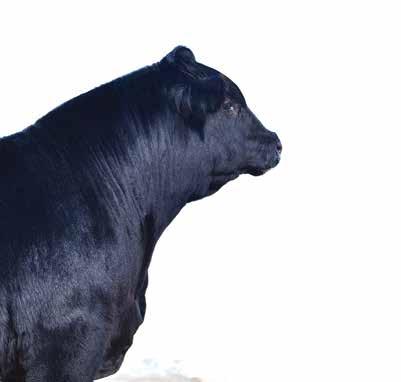
5 minute read
Performance Line
by Samantha Cunningham, PhD Geneticist for the North American Limousin Foundation
As consumers, we have a multitude of tools available to help us work “smarter not harder”—smart phones, super stores, meal delivery services, etc. As beef producers, we also have tools that help us make selection decisions more efficiently, to work “smarter not harder”, so to speak. There’s raw data, adjusted data, ratios, EPDs (plus accuracies), economic value indexes and genomics all available to us for decision making and selection. Each of these have merit depending on the situation we find ourselves in—just like the tools in a literal toolbox. We wouldn’t use a screwdriver and a hammer to do the same job, would we?
Which is the best tool for the job? EPDs are the best tool available when considering the value of an animal as a parent. While this is true, we must keep in mind this does not account for differences in production environments; nor does it account for correlation among traits that could lead to unintended changes in one trait while selecting for another. Also, the multiple columns of EPD data we find in sale catalogs can be a bit overwhelming!
Indexes are not new to livestock production, swine and dairy producers have been using them for decades. Economic value indexes are calculated with production situations in mind, and most beef breed associations publish at least one index with their EPDs. Currently, NALF calculates and publishes one index—$MTI (mainstream terminal index).
Economic value indexes allow for multiple trait selection using one number expressed in dollars per animal. Multiple EPD values are each weighed by an economic value to give us that one index value that can help to simplify selection and mating decisions. We interpret index values like EPDs, so the difference between the index values of two bulls would be the expected difference in the average dollar value of progeny when bred to similar cows. It is important to note that accuracy values are not published for indexes, so caution should be used when making decisions involving young
continued on page 64


SPRING CREEKS CATTLE CO. BULL SALE
SUNDAY, FEBRUARY 13, 2022 • 1 PM CST FENNIMORE LIVESTOCK EXCHANGE, FENNIMORE, WI Selling 68 Head: 30 Limousin & Lim-Flex Bulls, 18 Angus Bulls, 20 Bred Females Sire Groups Include: Wulfs Apostle, Wulfs Endeavor C703E, Wulfs Conversion, Wulfs Gallagher, Wulfs Envoy, Wulfs Fifty, DFVC Growth Fund, GAR Ashland and Jindra Acclaim
Your Source For Quality Limousin, Lim-Flex, Angus and Red Angus seedstock. Call Today.
SALE MANAGEMENT:
KILEY McKINNA • 402-350-3447 WILEY FANTA • 320-287-0751 mcmarketingsales@aol.com www.mcmarketingmanagement.com 48715 Hilldale Rd. | Wauzeka, WI 53826 Bob Mitchell & Sons | Bart: 608-553-8070
2005 Ruhl Drive • Guthrie, OK 73044 405/260-3775 • Fax: 405/260-3766 www.Limousin365.com
BREEDER ADVERTISING RATES
FULL PAGE...................................................................................$1,150 2/3 PAGE.........................................................................................$950 1/2 PAGE.........................................................................................$775 1/4 PAGE.........................................................................................$500
All advertisements are 4-color process
ISSUE MATERIALS PUBLISHED
January - Spring Sale Edition Dec. 1 Dec. 23 April - Herd Bull Edition Mar. 1 Mar. 25 July - Breeder Directory Edition June 1 June 25 October - Fall Sale Edition Sept. 1 Sept. 25
Advertising materials to Kyle Haley 405/260-3775 • kbhaley2@gmail.com
CLOSING DATES
Refer to listing above.
ADVERTISING SKETCHES
Requests for advertising layouts must be in the L365 office 10 days before copy deadline.
TERMS
All accounts are due and payable as billed. Interest charges of 1-1/2% per month (18% APR) will be assessed to 30-day unpaid accounts. Customers with overdue accounts will be put on a prepay basis for subsequent advertising business.
CONTRACT DISCOUNT
L365 contracts for 4-time print and annual digital/print combinations are available at substantial discounts. Contact the L365 field representative in your area or call the L365 office at 405/260-3775.
DIFFICULT ADS
Ads requiring substantial extra production work will be assessed extra charges at standard shop rates. If you prefer no extra charges, request us to simplify the ad at our discretion if necessary.
COPY CHANGES
Alterations in advertising copy, if requested after closing date, will be made only if time permits.
REPRINTS
Advertising reprints are available. Requests for reprints must be made at the time the order for the ad is placed.
All other questions, contact the L365 office.
continued from page 62
sires and their index values. The accuracy values for the EPDs used to calculate an index are good indicators of the accuracy of an index. Just like with EPDs, as more records are added for an animal, an index value can change.
Understanding which EPD traits contribute to the index is important. Most breed associations publish definitions and/or fact sheets to help breeders better understand indexes and associated traits. Currently, Limousin breeders and customers have one index available: $MTI (Mainstream Terminal Index). It predicts genetic differences in profit per carcass by combining the potential for and value of postweaning growth, quality grade and yield.
When should you use an index? Which index should you use? It depends. Deciding to implement an index and which one to use will depend entirely on your production goals. If you keep replacements, zeroing in on a terminal index that assumes all offspring are marketed on a grid may not be the best choice; and in this instance, relying on EPDs that relate to maternal traits would be a better option. Conversely, if you have a bull customer that retains calves and later sells them on a grid-based system, encouraging them to use a terminal index, like $MTI, when buying bulls would be a good move.
Important considerations to take when implementing selection indexes: • More money is always better making higher indexes more attractive— these will only hold true if your production environment and management can handle the potential increase. • Like EPDs, indexes should be used for within breed selection only. • Also, like EPDs, bulls with identical figures can be very different phenotypically and have very different build, structure, size, etc.
Use caution. • Placing emphasis on a terminal-focused index could have antagonistic effects on maternal traits and vice versa.
Just like starting a new project and deciding which tools will lend to efficiency and success, understanding the technologies and tools we have available to us as cattle breeders is imperative to reach our production goals. We wouldn’t use a screwdriver and a hammer to do the same job, would we? Nor can we use a flathead or Phillips head screwdriver interchangeably, am I right?
ABOUT THE AUTHOR: Samantha Cunningham, PhD is an assistant professor of animal sciences at Colorado State University where she teaches undergraduate Animal Science courses with emphasis on hands on learning and livestock experience. Sam currently coordinates the CSU Seedstock Program that involves students in the merchandising and management of the University’s Angus and Hereford cow herds.







